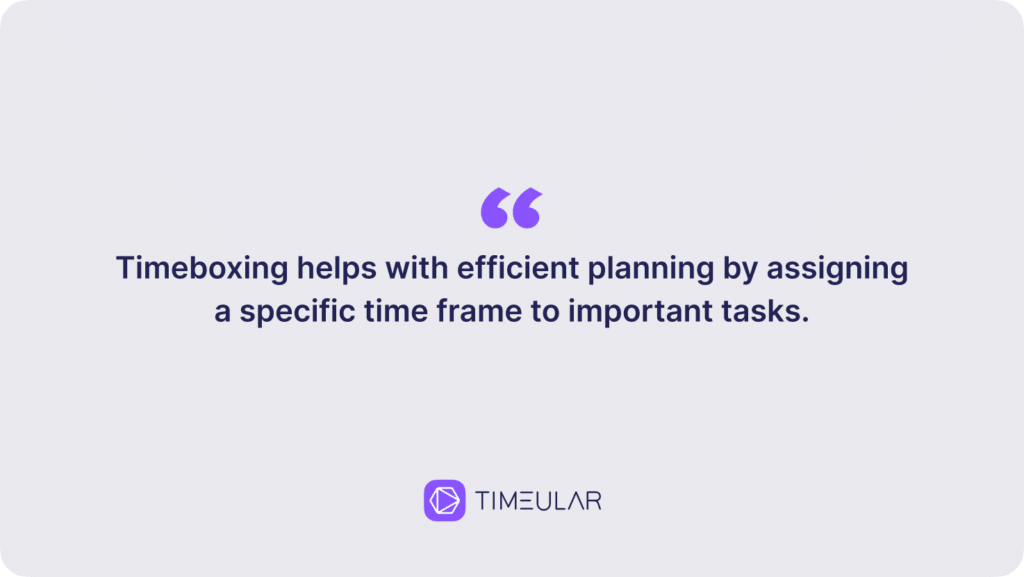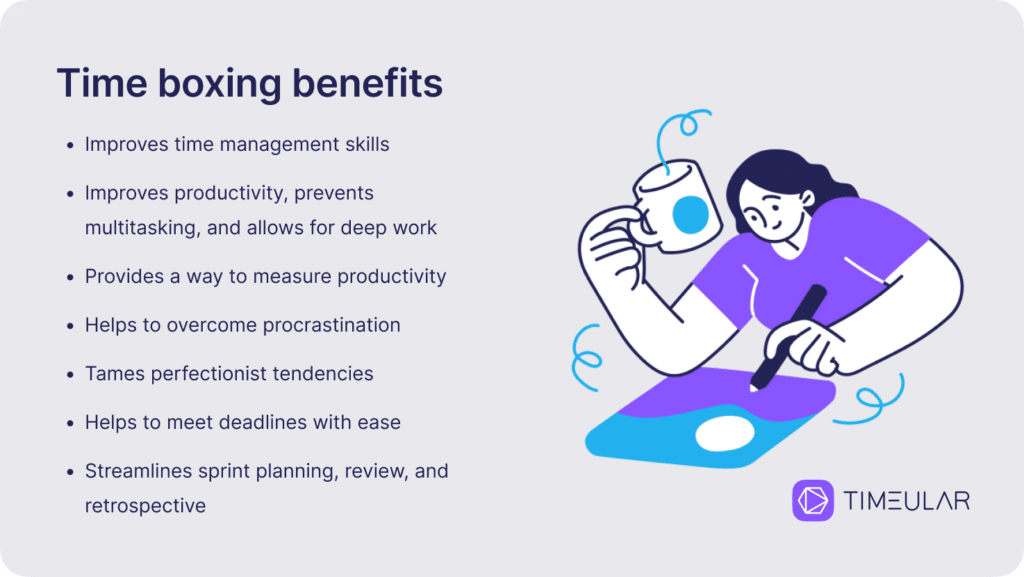Timeboxing: Definition, Benefits, and How It Works
If you’re looking for practical methods to improve productivity and make the most of your time, you’ve landed on the right page. In this article, I will explore the concept of timeboxing – one of the most efficient time management strategies used by successful teams and individuals.
What you will learn:
- What is timeboxing
- What are the benefits of timeboxing
- How to use timeboxing and stay focused
I started to use timeboxing a couple of months ago, and I wish I’d known it earlier! Let’s discover how dedicating a strict limit to individual tasks can help you, too, enhance focus and deliver more in less time.
- Download now for free: Timeboxing template
What is timeboxing?
Timeboxing, also known as time blocking, is a simple time management technique employed in Scrum and Agile project management. It helps with efficient planning by assigning a specific time frame to important tasks.
The crucial aspect of its success is maintaining focus on a single task within the allotted time, avoiding distractions or context switching.

How does it work? Implementing the timeboxing technique ensures efficient use of time and helps to complete project management tasks within the maximum unit of time, ranging from minutes to weeks or months based on task complexity.
You can use timeboxing to efficiently schedule individual tasks, help your team get organized, manage a project or plan meetings more effectively.
Example: Let’s say you’ve got a client asking for a social media strategy, a project that takes around 30 hours to wrap up. To hit that 10-day deadline, you’d need to slot in three-hour chunks each day. Or, if you prefer, you could go for five-hour blocks spread out over six days. It’s all about finding the right time blocks to get the job done on time.
Did you know that… The timeboxing technique capitalizes on the psychological phenomenon of establishing a strict deadline. Without such deadlines, you easily lose focus, and important tasks tend to expand in duration, as described by Parkinson’s Law.

“I’ve doubled my revenue thanks to Timeular and managed to halve how much I work” – Valdemar Alfred, Owner of Valdefar
The benefits of timeboxing
Although timeboxing is such a simple time management technique, it comes with endless benefits:
- Improves time management skills and helps to save time
- Improves productivity, prevents multitasking, and allows for deep work
- Provides a way to measure productivity
- Helps to overcome procrastination
- Tames perfectionist tendencies
- Helps to meet deadlines with ease
- Streamlines sprint planning, sprint review, and sprint retrospective
Let’s take a closer look at each of the benefits.

1. Helps to improve time management skills and save time
Timeboxing teaches you how to become responsible with your time, which is one of the key time management skills. With a strict limit of weekly or daily work hours and a set of tasks that take a specific amount of time, you make the most of every hour, ensuring you don’t lose time. Instead, you save time!
What’s more, timeboxing paired with a time tracking app helps you learn how much time specific tasks take so that you can better estimate the time of your projects and tasks in the future. This, in turn, enhances the process of planning your personal time and your team’s time.
2. Helps to increase productivity through deep work
Timeboxing, also known as time blocking, can help you check items off your to-do list fast. How? Working on the task in a deep work mode helps you use your mental resources in the most efficient way. When focusing on a single task, your brain doesn’t need to use up the energy on constant focus switches, and it saves power for dealing with the next task.
Additionally, a fixed time period for working on a task and a proper deadline make you move, move, move!
- Recommended read: How many work days in a year?
2. Measures productivity
Timeboxing, paired with a productivity time tracker helps to measure productivity by providing a clear framework for allocating time to tasks and projects. By setting specific time limits for each activity, you and your team can track progress and evaluate how efficiently you are utilizing your time.
This allows for a more accurate assessment of productivity based on the completion of tasks within the designated timeframes.
3. Prevents procrastination
Spending time on an unpleasant task requires a high level of self-discipline. If you don’t push yourself enough, you might end up procrastinating for the entire day or week, focusing on other projects or smaller tasks instead.
Luckily, timeboxing is a time management method that helps to overcome procrastination, too.
It breaks down even the most daunting tasks into manageable chunks. Setting a deadline creates a sense of urgency and makes you feel accountable for your time.
Another important aspect is the structured nature of timeboxing – it provides you with a ready plan for the day that reduces the overwhelm.
5. Tames perfectionist tendencies
They say better done than perfect. Well, not for those with a perfectionist mind who tend to over-engineer work, for whom work expands and each task takes much longer than actually needed. Don’t ask me how I know it 😉.
The good news is, timeboxing helps to fight the urge to make things perfect. It helps perfectionists like me avoid spending too much time stuck in a decision or concluding a project. When the timer rings, it’s time to take a short break and start a new task.
6. Helps to meet deadlines with ease
Timeboxing assists in estimating deadlines by providing insights into how long certain tasks or projects take to complete. This helps teams avoid over-promising and ensures that deadlines are realistic and achievable.
For team leaders, timeboxing also facilitates measuring the availability of resources for new projects. By analyzing how much time teams can dedicate to additional tasks within their existing work schedules, leaders can make informed decisions about project timelines and resource allocation.

How is timeboxing used in Agile and Scrum?
Timeboxing is like the secret sauce in Agile Software Development and Scrum – it keeps things moving and ensures everyone stays on track.
In Agile, it’s all about setting clear goals and sticking to them within specific time frames. This helps teams avoid the stress of missing deadlines and keeps the momentum going.
In Scrum, timeboxing is baked right into the process. Sprints, which are these focused bursts of work, have set durations, to get work done.
Even daily Scrum meetings, such as sprint planning or a sprint review, have time limits, so they must stay short and sweet. So, timeboxing isn’t just about managing time—it’s about keeping the whole team in sync and making sure things get done when they need to.

How to use the timeboxing technique
1. Estimate the time needed for a particular task
Start by estimating how long each task on your to-do list may take to complete and dedicate a specific time frame to it.
These estimations should include break time and buffer periods for any unexpected interruptions.
If you’re struggling with this step, read our guide about time estimation.
2. Decide how to spread your work
Now, you need to schedule specific time boxes in your calendar – two hours, three hours, or more – it’s entirely up to you. Just keep your deadline in mind.
Here, you can incorporate other time management techniques, like the Pomodoro Technique (make sure to use our free Pomodoro timer). The Pomodoro is a form of timeboxing that involves working in 25-minute segments, followed by a short 5-minute break each.
In alternative to the Pomodoro technique, there are many time management techniques you can apply. Remember to incorporate breaks in your focus sessions. They’ll help you keep your energy levels high.
🎯 Tip: I have a 2-hour time box scheduled for deep work every morning. It helps me start the day in the most productive way. Highly recommended!
3. Add your time blocks to your calendar
Use an analog or digital calendar, whatever works best for you. In Timeular, we use Google Calendar, which automatically creates time entries in our timesheets (Want to know how it works? Learn more about automatic time tracking).
When you create a time block in your calendar, add a note with a short description and expected outcomes. Don’t spend too much time on that, though; it’s just to help you navigate through your tasks.
4. Set a timer
Use your smartphone alarm or a time-tracking app to alert you when it’s time to finish one task and move on to the next. Understanding the importance of stopping at the exact moment the timer goes off is crucial for enhancing focus and ensuring tasks are completed within their allocated time, emphasizing the impact of timeboxing on task completion.
5. Assess and review
What happens if you can’t finish the task during the allocated time to perform it? Every time you check off a time box, you should assess and review how it went.
Suppose you haven’t completed the current task on time. Review your progress and try to understand what you should have done differently. Do you need more time for this type of work? Do you need to schedule your tasks in another order?
Reaching your goals does not always mean completing the task in one go. The answer is in assessing your needs and those of the project.
6. Reward yourself
Try to create positive associations with task completion, and reward yourself!
This attitude will motivate you to check off more tasks from your to-do list. There are many ways you can reward yourself. Having a refreshing walk, playing with a pet, eating a delicious and healthy snack, or listening to some soothing music are simple yet effective ways to reward yourself.

Helpful strategies for a successful timeboxing
1. Make your time boxes visible and colored
Colour your time boxes to help you navigate your weekly or daily plan. Whether you choose to work with an analog or digital calendar, assign distinct colours, emojis, or codes to each time box so that you can easily differentiate between them.
2. Define the type of timeboxes
There are two types of time boxes: hard time boxes and soft time boxes. Define each of your time boxes to get a better overview of what awaits you during a day or a week.
A hard time box is a fixed period dedicated to a stand-alone task. The previous and the following time box are unrelated to the hard time box.
A soft time box is, instead, a timebox that is part of a set of related tasks. Once a soft timebox is finished, there’s the following one that is related and dependent on it.
An example of a hard time box could be hosting a Retrospective meeting. A soft time box could be, instead, researching an article idea, which is part of the more extensive story of writing a piece of content.
3. Commit to your timeboxes with a strict deadline
Think of timeboxes as meetings you’ve scheduled with yourself. Resist the temptation to cancel them. Commit to the timebox and respect its start and end.
4. Set a timer
Setting a timer will help you hold yourself accountable to the expectation of time you set yourself, and alert you when that time is up.
5. Protect your focus time
The secret to the effectiveness of timeboxing is helping you focus on the task at hand. Minimize the chance of interruptions when you’re in the flow. For example, mute your phone and Slack notifications – they are some of the biggest enemies of productivity at work.
6. Don’t forget to take breaks
Time management tools or productivity techniques are designed to help you be productive, but you need to remember to care for your down time and protect it. Make sure you’re taking short breaks between your time boxes: stretch, walk around for a bit, or do a short yoga sequence.
7. Integrate your calendar with a time tracker
If you’re using a time tracker to measure time boxes, compare the results of your workday with the time planned.
By integrating the time tracker with your calendar, you’ll see how long it takes to accomplish a task, and you’ll be more accurate with your planning next time.
Common mistakes you should avoid when time boxing
- Don’t switch tasks until the allotted time has passed
- Respect the time limit of each time box. Don’t stretch or reduce it
- Don’t fill your calendar back to back without considering breaks or buffer time
- Don’t forget to match your tasks with the times of day when you’re typically most productive
- When working on the task, don’t distract yourself with social media or Slack notifications
- Don’t forget to set an alarm for each time box in your time management app
Timeboxing FAQ
Who created timeboxing?
The concept of timeboxing was introduced by James Martin, a book author known for his work on agile software development. In his book, Martin outlined the effectiveness of timeboxing in enhancing productivity and managing projects more efficiently.
I’m finding it difficult to finish my task before the timebox ends. How to solve it?
Many people may encounter this issue right in the beginning. It’s part of the timeboxing adaptation process. Begin by trying soft timeboxes, so you can still finish tasks if you underestimate how long they should take.
With time, and with more timeboxes you set, you’ll get better at estimating how long a task takes. Time tracking also helps tremendously in learning how long a task will take.
What if timeboxing results in me rushing tasks, lowering the quality of my work?
It’s important to be realistic when setting goals for each time box. The goal of this technique isn’t to squeeze out every ounce of productivity you have. Make sure you’re being realistic about how long the work will take.
What if my time boxes are too short for my project?
The simple answer is to make your time boxes longer within the next sprint. When you’re starting your timeboxing journey, breaking work or a project into smaller chunks can also help you understand how you’re using time and how long specific tasks take.
Does Elon Musk use timeboxing?
Elon Musk, renowned for his exceptional productivity, employs the timeboxing time management technique to optimize his workflow. By allocating specific blocks of time for each task, Musk effectively manages distractions and maintains focus, even in high-pressure situations.
With timeboxing, he sets clear boundaries and adheres to predetermined timelines, enabling him to accomplish tasks efficiently and stay on track throughout the day. This technique plays a vital role in Musk’s ability to navigate chaos and remain productive in his endeavors
Who uses timeboxing?
Elon Musk and Bill Gates use timeboxing. This method may take some effort to master, but it definitely helps sharpen focus and increase productivity.
The big takeaway from this method is the way it increases the awareness surrounding the time a task will eventually take.